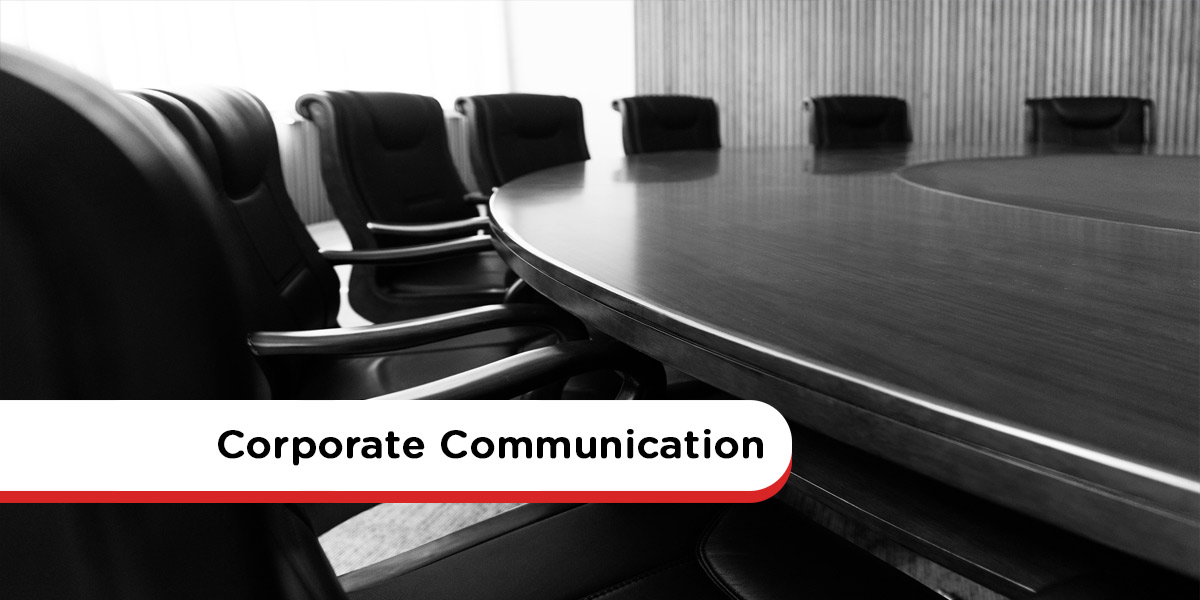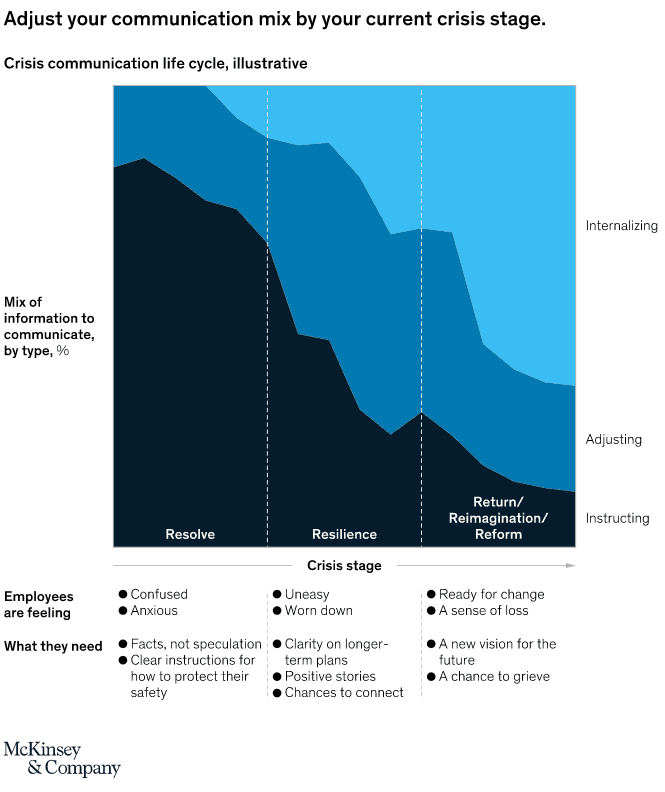
Your New Intranet Starts Here
Streamline communication, boost collaboration, and empower your team with MyHub's intuitive intranet solution.
Book a live demo now and experience the difference.
Take a Quick TourCorporate communication is the lifeblood of a successful business. Get it right, and your company thrives through strong brand identity, alignment, and trust. Get it wrong, and the impact can be costly, from employee disengagement to reputational damage. Despite its importance, many organizations still take communication for granted. Often, comms happen spontaneously and lack coordination between internal and external messaging.
This article is essential reading for comms professionals, CEOs, and small business owners alike. We explore the key concepts, provide real-world examples, and answer common questions about corporate communication strategies, helping you evaluate your current efforts and stay on track for long-term success.
What Is Meant By Corporate Communication?
Corporate communication refers to the structured exchange of messages, information, and ideas within and outside an organization. It encompasses interactions aimed at employees, customers, investors, and other stakeholders, ensuring that everyone is aligned and informed.
There are three main ways to deliver corporate communications effectively:
- Written communications: This includes website content, advertising copy, company newsletters, social media posts, emails, and formal business reports.
- Visual communications: Think logos, brand imagery, infographics, and slide decks that visually represent your company and its values.
- Audio-visual messaging: Examples include corporate videos, online webinars, live-streamed events, and podcasts that share insights and updates.
What Are The Different Types of Corporate Communication?
Corporate communication is typically divided into two categories: internal communication and external communication. Each plays a distinct role in shaping how your organization functions and is perceived.
Internal Communication
Internal communication involves the flow of information within an organization, from leadership to teams and between departments. It includes top-down directives, two-way conversations, and feedback loops from employees to management.
The primary goal is to ensure smooth operations, inform employees about strategic goals, and enhance company culture. It also supports initiatives such as employee engagement, knowledge sharing, and team collaboration.
External Communication
External communication focuses on how your organization interacts with the outside world. This includes customers, potential clients, shareholders, investors, suppliers, and media outlets.
The aim is to build brand reputation, promote products and services, and maintain public trust. Effective external communication ensures that your company is perceived positively and consistently across all external touchpoints.
What Are Examples Of Corporate Communication?
Examples of internal communication tools include:
- Town hall meetings
- Company intranet platforms
- Staff newsletters and email updates
- Departmental team meetings
- Internal blogs and knowledge-sharing portals
- Knowledge management systems
Examples of external corporate communication include:
- Official company websites
- Advertising campaigns
- Social media content and engagement
- Public press conferences and media statements
- Annual reports for stakeholders
- Sales brochures and promotional materials
What Is The Role Of Corporate Communication?
The role of corporate communications is multifaceted. Internally, it ensures that teams are aligned, informed, and motivated. Externally, it works to shape public perception and build lasting relationships with customers, media, and stakeholders.
Ultimately, effective communication is a strategic business function that influences reputation, performance, and growth. Here’s how:
Brand Awareness
Communications play a key role in building and reinforcing your brand image. Through consistent messaging and visual identity, companies can increase visibility, stand out from competitors, and remain top of mind with their audience.
Corporate Identity
Your corporate identity defines who you are. Through deliberate communication, you shape how internal and external audiences perceive your brand. A strong identity builds trust, drives loyalty, and contributes to business sustainability and employee advocacy.
Employee Engagement
Engaged employees are more productive, innovative, and committed. According to Forbes, highly engaged teams are 61% more profitable. Organizations with top-tier internal communication programs consistently rank higher in employee satisfaction and retention.
Employee Productivity
Clear and consistent communication improves employee productivity by reducing misunderstandings, speeding up decision-making, and fostering collaboration. With the right communication tools in place, employees can work more efficiently and contribute more effectively to organizational goals.
How Does Corporate Communication Differ From PR And Marketing?
That’s a great question, as there is often some overlap between the different functions.
As we have seen, corporate communication oversees all internal and external messaging. It ensures that every message from the company is aligned, consistent, and strategically delivered.
By contrast, public relations (PR) has a narrower focus. PR is responsible for managing external stakeholder communication, including the media, government agencies, and consumer forums. The PR team handles media relations, issues press releases, and delivers public statements. PR professionals often work in close partnership with corporate communications to maintain a positive public image.
Marketing has a different scope and is dedicated solely to customer engagement. The goal is to support sales and brand visibility through various channels. Marketers develop campaigns, manage social media, and create promotional materials. Corporate comms supports marketing by identifying content that appeals to new target audiences.
The bottom line: PR and marketing are distinct yet integrated parts of the broader corporate communication strategy.
Challenges Of Corporate Communication
Corporate communication plays a crucial role in shaping a company’s success. To enhance your efforts, it’s important to be aware of common pitfalls that can undermine your strategy.
Information Overload
Overloading your internal or external audiences with too much content can backfire. According to one survey, 80% of employees worldwide report experiencing information overload. This can lead to confusion, disengagement, and a negative brand perception. Carefully curate your communications to avoid unnecessary noise.
Mixed Messages
Inconsistent use of communication channels or poorly coordinated messaging creates confusion. When messages are unclear or contradictory, your audience may tune out entirely. Ensuring message clarity and coherence is essential.
Contradictory Information
Whether internally or externally, messaging that appears out of sync can damage your company’s credibility. Every touchpoint should reinforce the same core values and tone of voice.
How Can We Improve Our Corporate Communication?
Corporate communication may seem simple–just agree on a message and send it out, right? But ensuring consistency across departments and platforms requires careful planning. Even small businesses risk misalignment without a structured approach.
The following four tips will help you strengthen your internal and external messaging:
1. Develop A Plan
When it comes to effective communication, a strategic plan is essential. It ensures your messages are aligned with organizational goals and reduces the risk of overload or confusion.
Start by defining clear objectives and assigning responsibilities. Ideally, a senior executive should oversee corporate comms to maintain alignment at the highest level.
Then, segment your target audiences–both internal and external–and select appropriate channels for each. For instance, a new acquisition might warrant a press release or an industry magazine ad, while internal changes might be best delivered via an intranet.
Finally, track your success. Use KPIs such as click-through rates, downloads, employee engagement, and customer feedback. Combine analytics with surveys and focus groups for a well-rounded performance review.
2. Have A Consistent Message
Your communication plan should promote message consistency. Everyone representing the company should undergo training to ensure alignment with your brand voice and values.
If marketing shares a different message from the CEO’s office, it can undermine trust. Ensure all departments are on the same page and equipped with the right tools and training.
3. Have A Professional Comms Team
Effective communication requires skilled professionals. Your corporate comms team should possess excellent writing, presentation, and analytical skills, and be capable of handling a crisis.
Outsourcing specialized areas like social media management is common, but it’s essential to maintain an internal point of contact to oversee the overall strategy. Once in place, empower your team to execute campaigns aligned with your business vision.
4. Invest In The Right Technology
The right communication tools can enhance message delivery and employee engagement, especially in hybrid workplaces. Technology enables streamlined, multi-channel communication across diverse teams.
For internal communications, consider:
- Intranets
- Team chat
- Company blogs
- Webinars
- Hybrid events
For external communications, explore:
- Extranets
- Client portals
- Business instant messaging
- Podcasts
- Social media platforms
Some technologies serve both internal and external audiences. Use a mix of written, visual, and audio-visual formats to create a dynamic communication experience.
8 Communication Best Practices
1. Plan For Success
In many organizations, communication happens spontaneously. However, if you want to deliver the right message at the right time and through the right communication channel, you need a solid plan.
Top-performing companies know that effective communication doesn’t occur by chance. With diverse audiences, messages, and mediums, a defined communications strategy is the essential first step.
A strategic plan gives direction and structure to your overall messaging approach. Start by identifying your communication goals: What do you want to achieve?
Next, analyze your target audiences–from customers and stakeholders to different employee groups across locations or job functions.
Then categorize the types of messages you share, like staff updates, product announcements, or stakeholder collaboration news.
Choose suitable communication channels for each group. For example, customers may respond best to social media updates, while internal teams might prefer alerts via business IM or intranet newsfeeds.
Finally, set a communications budget. Allocate resources wisely to ensure your efforts are impactful and sustainable. A well-thought-out strategy makes implementing the next best practices much smoother.
2. Make It Personal
With data overload on the rise, personalized and targeted messaging is more important than ever. Tailored content ensures your messages stand out and reach the right audience.
Encourage staff to define their communication preferences. For instance, in your team chat system, create topic-specific channels like #sales, #marketing, or #bigideas. Employees can follow only the topics they care about and mute notifications when focus is needed.
Similarly, enable personalized intranet feeds that blend company news with team updates. Social features like user-generated walls and “follow” functions give staff control over the flow of information.
The result? Fewer distractions, less irrelevant chatter, and improved productivity.
3. Tell A Story
Facts and figures are quickly forgotten, but storytelling sticks. Using real-life examples and narratives helps your corporate messages resonate on an emotional level.
Instead of publishing a bland memo, explain a new policy –l ike an employee wellness initiative – through a relatable story. Show how it impacts daily work.
Give employees a voice, too. Share “day in the life” features, employee spotlight blogs, or behind-the-scenes stories. This approach humanizes your brand and strengthens internal engagement.
4. Keep It Visual
As Kim Garst puts it, “Visuals express ideas in a snackable manner.” That’s why visual communication is essential in the digital age.
Infographics, videos, charts, and slide decks allow you to deliver more information in less time–and in a way that’s engaging and easier to process.
High-performing organizations prioritize visual elements in their communication strategies to inspire, inform, and retain attention.
5. Ensure Communication Is Two-Way
Gone are the days of one-way, top-down communication. Today’s best practice is multi-directional communication that supports collaboration and feedback.
Enable open communication channels across all levels–upward, downward, and laterally. Use tools like blogs, forums, IM, and activity walls to encourage feedback and idea sharing.
Two-way communication builds a collaborative company culture where employees feel heard and valued, increasing motivation and engagement across the board.
6. Allow For Informal Communication
According to Upwork’s Future Workforce Report, 36.2 million Americans will be working remotely by 2025. However, the spontaneous, informal chats that build connection are harder to replicate virtually.
Today’s communication best practices support informal interaction, especially for remote teams. Channels like #random or #timeout in Slack or your team chat provide space for casual conversation–from weekend plans to funny memes.
Emojis, quizzes, and social walls help foster community and boost morale in hybrid workplaces. These virtual “water cooler” moments are more important than ever in preventing isolation and improving team cohesion.
7. Delivery Is As Important As The Message
Even the best-crafted message fails if it’s not delivered effectively. Consider your audience’s accessibility and preferences when selecting a channel.
For example, many non-desk employees lack email access. An SMS alert or instant message might be more appropriate. Regularly check with employees, customers, and stakeholders about their preferred platforms.
Monitoring evolving communication habits ensures your message reaches the right people in the right place – and at the right time.
8. Measure Success
In today’s data-driven world, “set and forget” communication is no longer acceptable. Ongoing performance measurement is key to refining and improving your strategy.
Track both qualitative and quantitative metrics. These may include:
- Email open rates
- Downloads and file views
- Click-through rates (CTR)
- Social interactions–likes, shares, comments
- Survey responses
- Focus group feedback
Metrics reveal whether your messages are effective and whether adjustments are needed. Regular review ensures your communications strategy stays aligned with business goals and audience expectations.
5 Best Practices to Improve Your Personal Communication
Effective communication isn’t just important at the corporate level–it starts with the individual. In any organization, communication is only as strong as the people who practice it. Here are five personal communication best practices to enhance clarity and connection.
- Actively Listen: Whether you’re the CEO or a frontline employee, active listening is essential for meaningful conversations. The best communicators listen more than they speak. This means fully concentrating on the speaker, summarizing key points, and asking thoughtful questions to clarify. Pay attention to non-verbal cues too–maintain eye contact, keep an open posture, and show you’re engaged.
- Be Clear And Concise: To ensure your message lands, it must be clear and concise. Avoid unnecessary jargon and be upfront about your goals. Include a direct call to action to avoid ambiguity. Use simple language and remove filler content. Writing tools like Grammarly can help streamline your communication and eliminate fluff.
- Be Relevant: Great communicators tailor their message to the audience. Relevance increases engagement and understanding. Consider who you’re speaking to–a message for a customer will differ from one for a teammate. Adjust your tone, language, and delivery method accordingly to match the recipient’s expectations and needs.
- Be Responsive: Responsiveness signals respect and reliability. Make it a habit to respond to emails, messages, and phone calls in a timely manner. Prompt replies help foster trust, improve team collaboration, and show clients and colleagues that their time and input are valued.
- Check Before You Send: Always proofread your messages before hitting send. Typos and grammatical mistakes can damage your credibility, especially when relying on mobile devices and predictive text. Use spell checkers or ask a colleague to review your message. Even better, revisit your message after a short break to catch overlooked errors with fresh eyes.
Best Practice Tips For Executive Communications
The recent global crises have underscored the importance of transparent and strategic executive communication. Here’s how leaders can build trust, improve morale, and keep staff informed in challenging times.
Be Authentic
Employees value authentic communication – messaging that feels real, personal, and relatable. It’s not just about what you say but how you say it. A CEO blog is an ideal platform to share personal reflections and updates. Icons like Richard Branson and Mark Zuckerberg have successfully used blogs to connect emotionally with their teams. For instance, Zuckerberg’s A Letter To Our Daughter was shared over 300,000 times and resonated globally.
Even if your audience is smaller, a similarly authentic message can leave a big impact. Use video messaging for a personal touch – especially with remote teams. Smartphone cameras now offer affordable, high-quality options for executive communication. Consider livestream Q&As and post replays on your intranet newsfeed to expand reach.
To promote transparency, record boardroom or virtual executive meetings and share highlight reels internally. This gives staff insight into leadership discussions and encourages trust across the organization.
Evolve Your Communications
Every crisis follows a life cycle–resolve, resilience, return, reimagination, and reform, as outlined by McKinsey. Adaptive communication helps meet the evolving emotional needs of staff during each phase. Tailor your message style, content, and tone to reflect the current stage and team sentiment. The key is to “give people what they need, when they need it.”
Use A Variety Of Communications Channels
Modern workplaces are multichannel ecosystems. Effective executive communication must span multiple platforms–from traditional email and newsletters to intranets and instant messaging. This ensures consistent messaging for in-office, remote, and non-desk workers.
Equally important is allowing for two-way communication. Feedback loops encourage employees to share ideas, express concerns, and feel heard. A #changemanagement channel on your internal chat system is one effective way to foster engagement, address rumors, and build alignment across teams.
Measure The Impact Of CEO Communications
Like any strategic initiative, executive communication must be measurable. Use a combination of quantitative and qualitative data to track ROI and effectiveness. Metrics such as employee engagement scores, retention rates, customer satisfaction, and even sales data can reveal insights.
Gather employee feedback through surveys, polls, and focus groups. Ask questions like:
- What channels do you prefer for leadership communication?
- Are executive messages clear, timely, and transparent?
- Do you feel informed and involved?
- What improvements would you suggest?
Monitor KPIs such as open rates, click-throughs, and social shares to assess reach and resonance. This data-driven approach helps refine messaging strategies and maximize internal communication effectiveness.
Best Practice Examples Of Leadership Communications
To inspire and motivate, we share below some real examples of executive communication at its best. These leaders embody key traits that set them apart: authenticity, honesty, and an innate ability to genuinely connect with people.
Jacinda Ardern, Prime Minister of New Zealand
Jacinda Ardern has won widespread praise for her distinctive style of executive communications during challenging times. Her deep sense of empathy and compassion for those affected by the 2019 Christchurch terror attacks earned admiration worldwide.
More recently, throughout the Covid-19 pandemic, Prime Minister Ardern used clear, appropriate language and communication techniques to engage her audience effectively. In sports-obsessed New Zealand, her policy of ‘go hard, go early’ strongly resonated with Kiwis. During the height of the crisis, she made herself highly accessible by appearing at daily news conferences. For many New Zealanders, tuning into the 1 pm daily briefings became a vital ritual throughout the 6-week lockdown.
Ardern consistently reinforced clear, motivating messages, repeatedly referring to the nation as ‘a team of five million.’ She encouraged Kiwis to ‘be strong, be kind, and unite.’ There’s no doubt that Jacinda Ardern’s authentic and consistent leadership communication won the hearts and minds of her fellow citizens.
Brian Cornell, Target CEO
Another outstanding example of effective executive communication is Brian Cornell. Empathetic and authentic, the Target CEO has successfully aligned both internal and external messaging throughout the pandemic.
Cornell’s note to guests about the coronavirus confirmed his commitment to the safety and health of customers and staff. He clearly outlines the proactive steps Target is taking to assist and maintain product supplies, while emphasizing the importance of caring for employee well-being.
In a subsequent update on how we’re supporting our guests and team, Cornell continues his ‘mixternal’ approach, detailing additional measures such as paid illness leave, family leave, and free counseling for employees.
By successfully aligning the internal and external communication, Cornell has strengthened Target’s brand reputation. His carefully chosen, empathetic language builds deep trust with stakeholders both inside and outside the company.
Executive Communications: Key Messages
The coronavirus pandemic has underscored the critical importance of executive communications. Honest, consistent, and regular messaging is essential during these difficult times. Staff require the reassurance and support of C-suite executives now more than ever. Therefore, be genuine and authentic in your communications. Above all, make yourself highly visible and accessible.
Employees mirror what they observe and hear from executives in their own communications with customers and stakeholders. It is therefore crucial to get executive communication right–it could be the deciding factor that helps your business survive and thrive in the post-COVID world.
Success in executive communications demands a thoughtful approach to the employee lifecycle and crisis management. Evaluating best practices for communication channels, content, and timing helps leaders optimize their communication efforts. When planning your executive communications strategy, consider how it can enhance employee engagement, retention, productivity, and morale. The ultimate goal is to foster strong, trust-based relationships between leaders and employees across the organization.
To support executive communications, MyHub offers an all-in-one intranet software solution. This platform integrates multiple tools designed to deliver important executive messages effectively, including news feeds, blogs, discussion forums, instant messaging, and employee surveys. Learn more by signing up for a free 14-day trial today, or request a free demo from one of our design experts.
FAQ Section
What is corporate or internal communication?
Corporate communication refers to how an organization shares information internally and externally. Internal communication (IC) focuses on delivering consistent messages to employees through tools like intranets, newsletters, or meetings.
Why is strong internal communication important?
Effective internal communication drives employee engagement, reduces silos, improves collaboration, and supports faster decision-making. It creates a cohesive work environment and encourages two-way dialogue.
How can an intranet enhance corporate communication?
An intranet provides a secure, centralized hub for news, documents, staff profiles, automated workflows, and interactive forums—making information easier to find and fostering connection and participation among teams.








